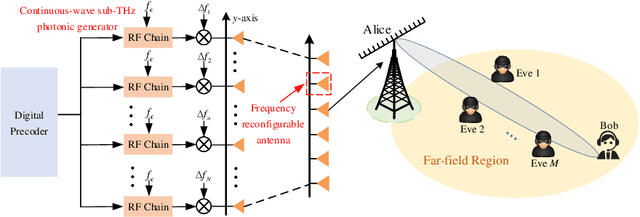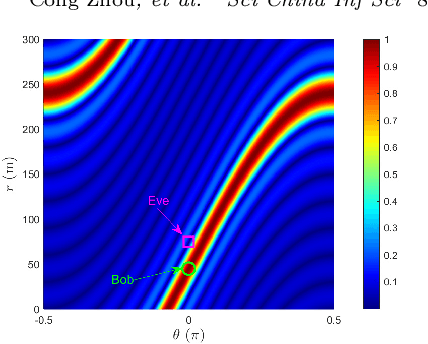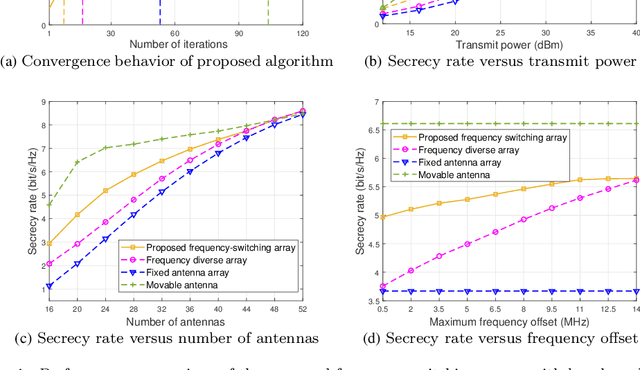Weidong Mei
Performance Optimization for Movable Antenna Enhanced MISO-OFDM Systems
Oct 02, 2025Abstract:Movable antenna (MA) technology offers a flexible approach to enhancing wireless channel conditions by adjusting antenna positions within a designated region. While most existing works focus on narrowband MA systems, this paper investigates MA position optimization for an MA-enhanced multiple-input single-output (MISO) orthogonal frequency-division multiplexing (OFDM) system. This problem appears to be particularly challenging due to the frequency-flat nature of MA positioning, which should accommodate the channel conditions across different subcarriers. To overcome this challenge, we discretize the movement region into a multitude of sampling points, thereby converting the continuous position optimization problem into a discrete point selection problem. Although this problem is combinatorial, we develop an efficient partial enumeration algorithm to find the optimal solution using a branch-and-bound framework, where a graph-theoretic method is incorporated to effectively prune suboptimal solutions. In the low signal-to-noise ratio (SNR) regime, a simplified graph-based algorithm is also proposed to obtain the optimal MA positions without the need for enumeration. Simulation results reveal that the proposed algorithm outperforms conventional fixed-position antennas (FPAs), while narrowband-based antenna position optimization can achieve near-optimal performance.
Frequency-switching Array Enhanced Physical-Layer Security in Terahertz Bands: A Movable Antenna Perspective
Jul 02, 2025


Abstract:In this paper, we propose a new frequency-switching array (FSA) enhanced physical-layer security (PLS) system in terahertz bands, where the carrier frequency can be flexibly switched and small frequency offsets can be imposed on each antenna at Alice, so as to eliminate information wiretapping by undesired eavesdroppers. First, we analytically show that by flexibly controlling the carrier frequency parameters, FSAs can effectively form uniform/non-uniform sparse arrays, hence resembling movable antennas (MAs) in the control of inter-antenna spacing and providing additional degree-of-freedom (DoF) in the beam control. Although the proposed FSA experiences additional path-gain attenuation in the received signals, it can overcome several hardware and signal processing issues incurred by MAs, such as limited positioning accuracy, considerable response latency, and demanding hardware and energy cost. To shed useful insights, we first consider a secrecy-guaranteed problem with a null-steering constraint for which maximum ratio transmission (MRT) beamformer is considered at Alice and the frequency offsets are set as uniform frequency increment. Interestingly, it is shown that the proposed FSA can flexibly realize null-steering over Eve in both the angular domain (by tuning carrier frequency) and range domain (by controlling per-antenna frequency offset), thereby achieving improved PLS performance. Then, for the general case, we propose an efficient algorithm to solve the formulated non-convex problem by using the block coordinate descent (BCD) and projected gradient ascent (PGA) techniques. Finally, numerical results demonstrate the convergence of the proposed optimization algorithm and its superiority over fixed-position arrays (FPAs) in terms of secrecy-rate performance.
Integrating Movable Antennas and Intelligent Reflecting Surfaces (MA-IRS): Fundamentals, Practical Solutions, and Opportunities
Jun 17, 2025Abstract:Movable antennas (MAs) and intelligent reflecting surfaces (IRSs) enable active antenna repositioning and passive phase-shift tuning for channel reconfiguration, respectively. Integrating MAs and IRSs boosts spatial degrees of freedom, significantly enhancing wireless network capacity, coverage, and reliability. In this article, we first present the fundamentals of MA-IRS integration, involving clarifying the key design issues, revealing performance gain, and identifying the conditions where MA-IRS synergy persists. Then, we examine practical challenges and propose pragmatic design solutions, including optimization schemes, hardware architectures, deployment strategies, and robust designs for hardware impairments and mobility management. In addition, we highlight how MA-IRS architectures uniquely support advanced integrated sensing and communication, enhancing sensing performance and dual-functional flexibility. Overall, MA-IRS integration emerges as a compelling approach toward next-generation reconfigurable wireless systems.
CNN-Based Channel Map Estimation for Movable Antenna Systems
May 27, 2025Abstract:Movable antenna (MA) has attracted increasing attention in wireless communications due to its capability of wireless channel reconfiguration through local antenna movement within a confined region at the transmitter/receiver. However, to determine the optimal antenna positions, channel state information (CSI) within the entire region, termed small-scale channel map, is required, which poses a significant challenge due to the unaffordable overhead for exhaustive channel estimation at all positions. To tackle this challenge, in this paper, we propose a new convolutional neural network (CNN)-based estimation scheme to reconstruct the small-scale channel map within a three-dimensional (3D) movement region. Specifically, we first collect a set of CSI measurements corresponding to a subset of MA positions and different receiver locations offline to comprehensively capture the environmental features. Subsequently, we train a CNN using the collected data, which is then used to reconstruct the full channel map during real-time transmission only based on a finite number of channel measurements taken at several selected MA positions within the 3D movement region. Numerical results demonstrate that our proposed scheme can accurately reconstruct the small-scale channel map and outperforms other benchmark schemes.
A Derivative-Free Position Optimization Approach for Movable Antenna Multi-User Communication Systems
May 25, 2025Abstract:Movable antennas (MAs) have emerged as a disruptive technology in wireless communications for enhancing spatial degrees of freedom through continuous antenna repositioning within predefined regions, thereby creating favorable channel propagation conditions. In this paper, we study the problem of position optimization for MA-enabled multi-user MISO systems, where a base station (BS), equipped with multiple MAs, communicates with multiple users each equipped with a single fixed-position antenna (FPA). To circumvent the difficulty of acquiring the channel state information (CSI) from the transmitter to the receiver over the entire movable region, we propose a derivative-free approach for MA position optimization. The basic idea is to treat position optimization as a closed-box optimization problem and calculate the gradient of the unknown objective function using zeroth-order (ZO) gradient approximation techniques. Specifically, the proposed method does not need to explicitly estimate the global CSI. Instead, it adaptively refines its next movement based on previous measurements such that it eventually converges to an optimum or stationary solution. Simulation results show that the proposed derivative-free approach is able to achieve higher sample and computational efficiencies than the CSI estimation-based position optimization approach, particularly for challenging scenarios where the number of multi-path components (MPCs) is large or the number of pilot signals is limited.
UAV-Enabled Passive 6DMA for ISAC: Joint Location, Orientation, and Reflection Optimization
May 15, 2025Abstract:Improving the fundamental performance trade-off in integrated sensing and communication (ISAC) systems has been deemed as one of the most significant challenges. To address it, we propose in this letter a novel ISAC system that leverages an unmanned aerial vehicle (UAV)-mounted intelligent reflecting surface (IRS) and the UAV's maneuverability in six-dimensional (6D) space, i.e., three-dimensional (3D) location and 3D rotation, thus referred to as passive 6D movable antenna (6DMA). We aim to maximize the signal-to-noise ratio (SNR) for sensing a single target while ensuring a minimum SNR at a communication user equipment (UE), by jointly optimizing the transmit beamforming at the ISAC base station (BS), the 3D location and orientation as well as the reflection coefficients of the IRS. To solve this challenging non-convex optimization problem, we propose a two-stage approach. In the first stage, we aim to optimize the IRS's 3D location, 3D orientation, and reflection coefficients to enhance both the channel correlations and power gains for sensing and communication. Given their optimized parameters, the optimal transmit beamforming at the ISAC BS is derived in closed form. Simulation results demonstrate that the proposed passive 6DMA-enabled ISAC system significantly improves the sensing and communication trade-off by simultaneously enhancing channel correlations and power gains, and outperforms other baseline schemes.
Robust Movable-Antenna Position Optimization with Imperfect CSI for MISO Systems
May 11, 2025Abstract:Movable antenna (MA) technology has emerged as a promising solution for reconfiguring wireless channel conditions through local antenna movement within confined regions. Unlike previous works assuming perfect channel state information (CSI), this letter addresses the robust MA position optimization problem under imperfect CSI conditions for a multiple-input single-output (MISO) MA system. Specifically, we consider two types of CSI errors: norm-bounded and randomly distributed errors, aiming to maximize the worst-case and non-outage received signal power, respectively. For norm-bounded CSI errors, we derive the worst-case received signal power in closed-form. For randomly distributed CSI errors, due to the intractability of the probabilistic constraints, we apply the Bernstein-type inequality to obtain a closed-form lower bound for the non-outage received signal power. Based on these results, we show the optimality of the maximum-ratio transmission for imperfect CSI in both scenarios and employ a graph-based algorithm to obtain the optimal MA positions. Numerical results show that our proposed scheme can even outperform other benchmark schemes implemented under perfect CSI conditions.
Mechanical Power Modeling and Energy Efficiency Maximization for Movable Antenna Systems
May 09, 2025Abstract:Movable antennas (MAs) have recently garnered significant attention in wireless communications due to their capability to reshape wireless channels via local antenna movement within a confined region. However, to achieve accurate antenna movement, MA drivers introduce non-negligible mechanical power consumption, rendering energy efficiency (EE) optimization more critical compared to conventional fixed-position antenna (FPA) systems. To address this problem, we develop in this paper a fundamental power consumption model for stepper motor-driven MA systems by resorting to basic electric motor theory. Based on this model, we formulate an EE maximization problem by jointly optimizing an MA's position, moving speed, and transmit power. However, this problem is difficult to solve optimally due to the intricate relationship between the mechanical power consumption and the design variables. To tackle this issue, we first uncover a hidden monotonicity of the EE performance with respect to the MA's moving speed. Then, we apply the Dinkelbach algorithm to obtain the optimal transmit power in a semi-closed form for any given MA position, followed by an enumeration to determine the optimal MA position. Numerical results demonstrate that despite the additional mechanical power consumption, the MA system can outperform the conventional FPA system in terms of EE.
Near-Field THz Bending Beamforming: A Convex Optimization Perspective
Mar 26, 2025



Abstract:Terahertz (THz) communication systems suffer severe blockage issues, which may significantly degrade the communica tion coverage and quality. Bending beams, capable of adjusting their propagation direction to bypass obstacles, have recently emerged as a promising solution to resolve this issue by engineer ing the propagation trajectory of the beam. However, traditional bending beam generation methods rely heavily on the specific geometric properties of the propagation trajectory and can only achieve sub-optimal performance. In this paper, we propose a new and general bending beamforming method by adopting the convex optimization techniques. In particular, we formulate the bending beamforming design as a max-min optimization problem, aiming to optimize the analog or digital transmit beamforming vector to maximize the minimum received signal power among all positions along the bending beam trajectory. However, the resulting problem is non-convex and difficult to be solved optimally. To tackle this difficulty, we apply the successive convex approximation (SCA) technique to obtain a high-quality suboptimal solution. Numerical results show that our proposed bending beamforming method outperforms the traditional method and shows robustness to the obstacle in the environment.
Flexible Intelligent Metasurface-Aided Wireless Communications: Architecture and Performance
Mar 14, 2025Abstract:Typical reconfigurable intelligent surface (RIS) implementations include metasurfaces with almost passive unit elements capable of reflecting their incident waves in controllable ways, enhancing wireless communications in a cost-effective manner. In this paper, we advance the concept of intelligent metasurfaces by introducing a flexible array geometry, termed flexible intelligent metasurface (FIM), which supports both element movement (EM) and passive beamforming (PBF). In particular, based on the single-input single-output (SISO) system setup, we first compare three modes of FIM, namely, EM-only, PBF-only, and EM-PBF, in terms of received signal power under different FIM and channel setups. The PBF-only mode, which only adjusts the reflect phase, is shown to be less effective than the EM-only mode in enhancing received signal strength. In a multi-element, multi-path scenario, the EM-only mode improves the received signal power by 125% compared to the PBF-only mode. The EM-PBF mode, which optimizes both element positions and phases, further enhances performance. Additionally, we investigate the channel estimation problem for FIM systems by designing a protocol that gathers EM and PBF measurements, enabling the formulation of a compressive sensing problem for joint cascaded and direct channel estimation. We then propose a sparse recovery algorithm called clustering mean-field variational sparse Bayesian learning, which enhances estimation performance while maintaining low complexity.
 Add to Chrome
Add to Chrome Add to Firefox
Add to Firefox Add to Edge
Add to Edge